Bridges that breathe fire, tightly packed tube houses, cascading rice terraces — these are just a few of the incredible, photo-worthy sights you’ll find in Vietnam. Travelling with a camera? Here are our favourite spots to snap away in Vietnam, plus insider tips on where to find the best angles.
Hanoi Train Street
In Hanoi, you can find the bustle and excitement in the Old Quarter with bars and pubs. You can also find the peacefulness in famous pagodas such as One Pillar Pagoda, Ly Quoc Su Pagoda. But, in the heart of Hanoi capital, there is a place where you can enjoy all of the above at the same time. That place is the iconic Hanoi Train Street. To enter this street, visitors can start going from the intersection with Dien Bien Phu, Tran Phu, or Phung Hung.
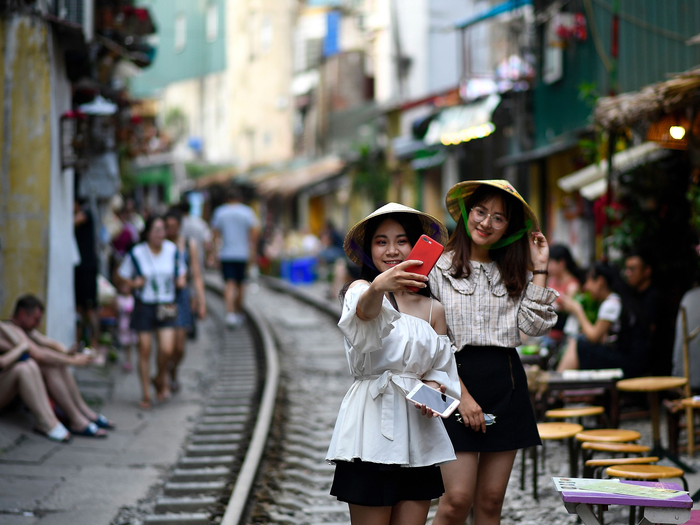 |
| Photo: Instagram |
The rail corridor from Kham Thien street to Giai Phong – Dai Co Viet intersection, from Dien Bien Phu street to Tran Phu street, from Phung Hung street to Long Bien bridge is home to old houses which embrace a part of Hanoians’ memories. Due to the railway, those corridors were dubbed “Pho Duong Tau” (or just Google map “Hanoi Train Street” and it’ll take you there).
The North-South railway of Vietnam was built during the French colonial era. Since then, people working in the railway industry began building houses by the trail corridor area. Each home becomes part of the little town, straight from Long Bien station to the end of Le Duan street. For more than 30 years, many generations have lived in this place. There are children born and grown up with the sound of the trains going through the street every day.
After appearing in several international newspapers, Hanoi Train Street suddenly became a famous tourist attraction. During the day, the street is peaceful and extremely suitable for visitors to come here to take a walk and shoot some memorable photos. With the background of old houses that have architecture characterizing the ancient Vietnamese atmosphere, not to mention the railway and its special curves that can be found only in this area, Hanoi Train Street will satisfy any photography lovers.
Long Bien Bridge
Hanoi, the capital of Vietnam for over 1,000 years, is famous not only for its unique cultural features, the modern and bustling life or the delicious traditional cuisine but also the constructions that have long become the symbol of Hanoi people. Among those architectures, Long Bien Bridge is a witness to the resilience of Hanoi in the two resistance wars as well as the dramatic changes of this city in the new epoch.
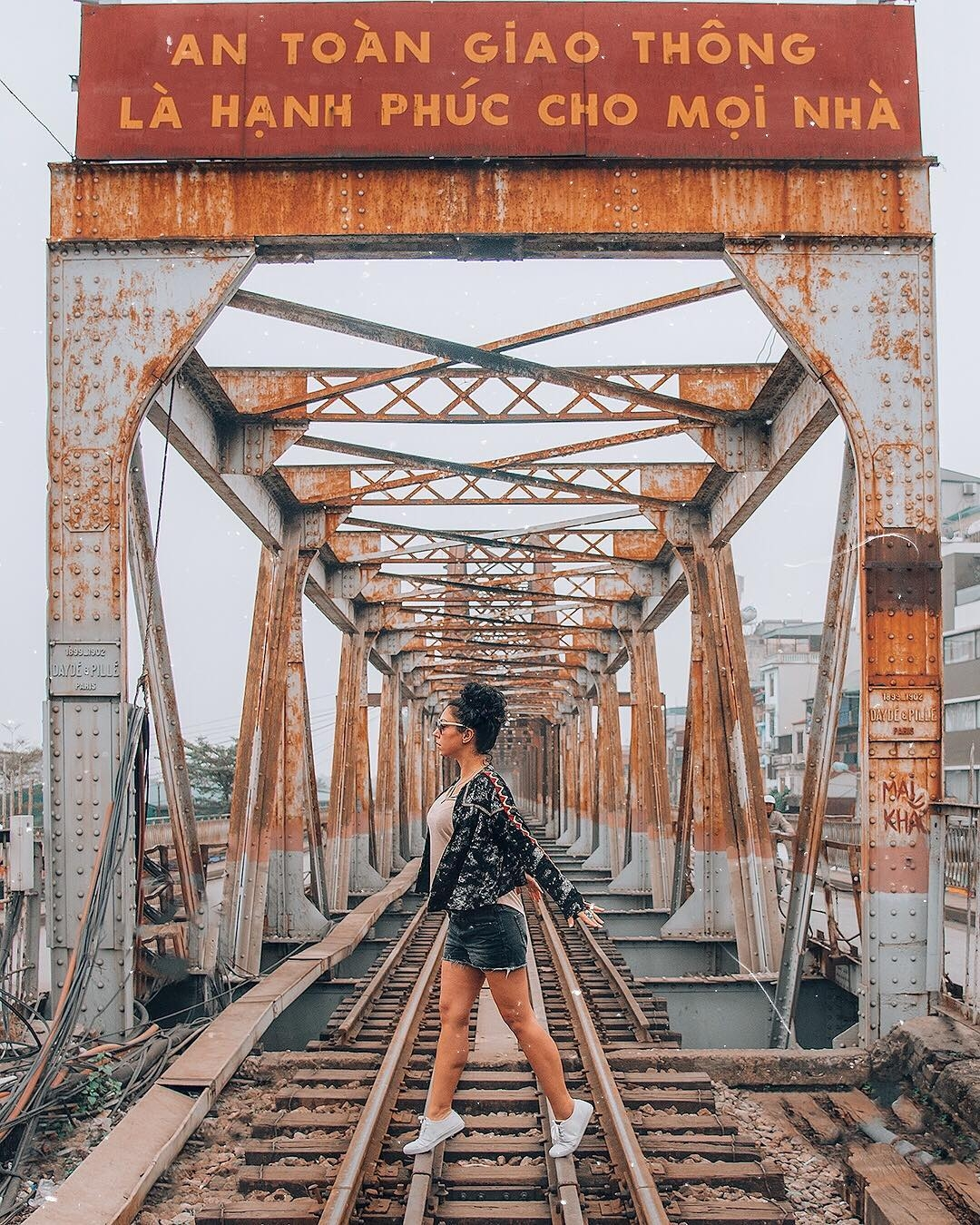 |
| Photo: ayda_june |
Long Bien Bridge is the first steel bridge in Hanoi, also one of the first bridges built by the French in Vietnam. The more than one-hundred-year-old bridge was constructed from 1899 to 1902 with the idea and construction of the architects Daydé & Pillé of Paris. At first, it was named after the Governor-General of French in Indochina – Paul Doumer. It was not until 1954 when the Vietnamese totally defeated the French in Dien Bien Phu that the bridge was renamed Long Bien Bridge.
During the resistance war against the United States, especially the period from 1965 to 1972, Long Bien Bridge was heavily bombarded by the US aircraft because of its crucial position connecting the two biggest cities in North Vietnam – Hanoi and Hai Phong. So serious was the war that the bridge was bombed fourteen times, destroying most of its spans. The remaining spans nowadays remind us about the unforgettable past of our country in general and Hanoi in particular.
In the peacetime, due to the drastic increase of vehicles since the 1990s, Long Bien Bridge has been used only for trains, motorcycles, bicycles and pedestrians. Not only is the bridge aim at transportation purpose but it is also an famous historical attraction in Hanoi the local residents and visitors.
Bai Tho Mountain
Lying on the center of the city with the height of more than 200 metres, Bai Tho mountain appears magnificently and majestically as a masterpiece that is carefully created by “The Mother of Nature” in her work of creating limestone mountains. Talking about Bai Tho mountain is reminding the historical flow of poetry and glorious victories of heroes of the mine land.
Not every local people in Quang Ninh has already known that Bai Tho mountain used to be called as “Roi Den” or “Truyen Dang Son” (means shining the light).
 |
|
Photo: Lolapan Travels |
According to some legendary stories about the mountain, its name as “Truyen Dang” was born when the ancient soldiers guarded on the mountain. If they saw the enemy coming, they will burn the spotlight to send the signal to the citadel.
The history of Bai Tho mountain written in the work of protecting and building the country closely attach with the glorious victory of the Hung Dao King – Tran Quoc Tuan in the battle against the Mongolia on Bach Dang historical river in 1228. Today, the important and strategic position of the mountain in this battle is still carved in the stone stele that: “From this mountain peak, thousands of years ago, stood a key watchtower of the border of the North East of the country. In the night the guards burned the signal lights, directed the boatmen to dock … “
If in the past, Bai Tho Mountain used to quietly “watch” the change of Quang Ninh, it today has “involved” in building the brand of tourism in Quang Ninh. the mountain has proved itself not only as an ideal stopover for people loving climbing but also an interesting exploration journey for people loving culture and history.
The difficult journey of exploring mystery always brings a surprise. Each mile of the road under the mountain also marks the time of the revolutionary activities in secret caves of the people of the mine land. Luckily, in the morning, visitors can accidentally see wild goats grazing.
Mua Caves
 |
| Photo: @mytravelcouple |
The cave brings you one of the best panoramic view of one of the nicest sceneries in Viet Nam- that’s Ninh Binh- which is known as a wonder of the world, the Telegraph from UK said “It’s an area known locally as Vietnam’s ‘Inland Halong Bay’” or Mua Cave – The Vietnamese “Great Wall of China”
This can’t be denied since more and more foreigners choose Mua Cave( Hang Mua – Vietnamese name) for their short holidays while being in the north of Viet Nam.
Mua Cave is near Hanoi city, far from it about 90 km. It belongs to a cultural land of Ninh Binh
Mua cave is located in Khe Dau Ha village, Ninh Xuan commune, Hoa Lu district, Ninh Binh province. Together with Trang An ecological tourism complex, the terrain of Mua cave looks majestic with rolling mountains surrounding a whole large delta like a rampart is protecting the country inside.
Do you know that the name of Mua cave was originated from an old time story, when the King Tran came to Hoa Lu captital, he often stopped at Mua cave so there were dancing performances by emperial maids, so people call the cave is “Mua” ( dancing).
Ban Gioc Waterfall
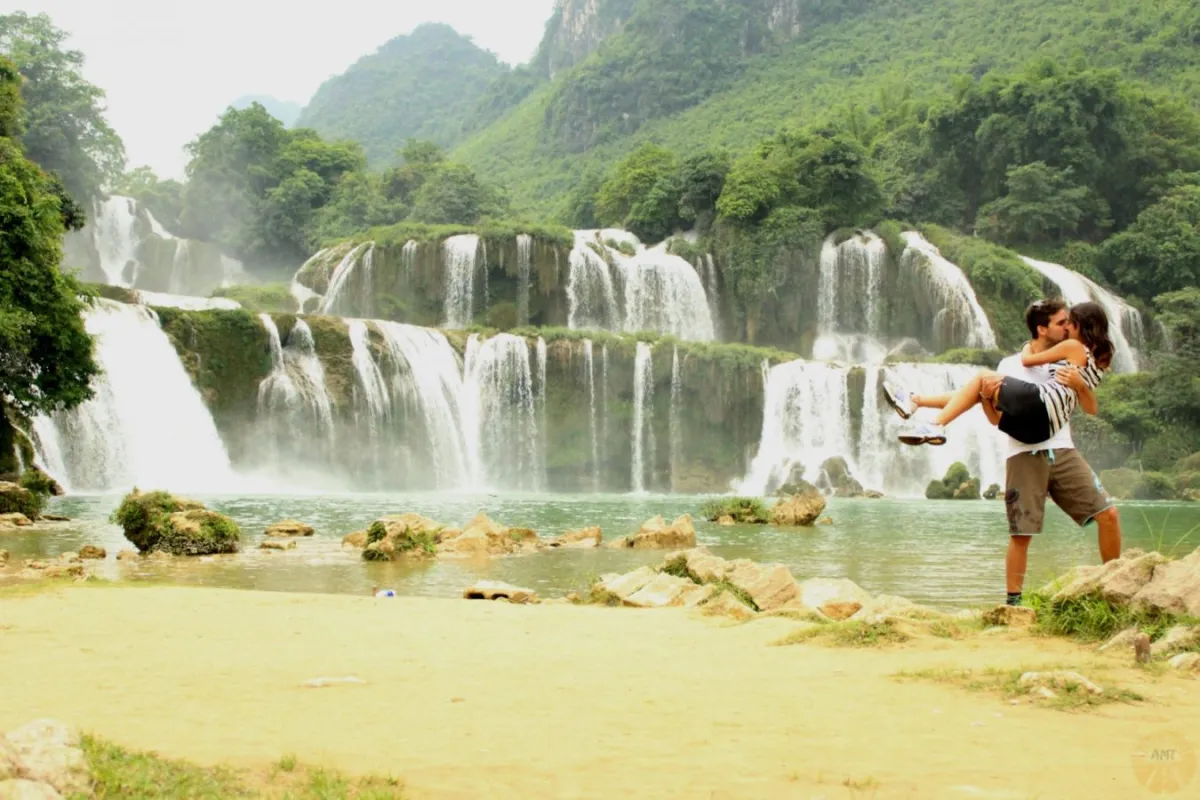 |
| Photo: A Million Travels |
Ban Gioc Waterfall is one of Vietnam’s most impressive natural sights. Located in the northeastern province of Cao Bang, the falls are 30 metres high and 300 metres across, making Ban Gioc the widest (but not the highest) waterfall in the country. The falls occur on the Quay Son River, a beautiful jade-blue body of water flowing from China through a pastoral landscape of rice fields and bamboo groves surrounded by limestone pinnacles. Despite improved road access and public transportation connections, and the popularity of several recent viral drone videos showcasing the majesty of the falls, Ban Gioc is still a relatively off-the-beaten-path sight. Mass tourism has yet to arrive and, outside of weekends and public holidays, there’s rarely more than a trickle of foreign and domestic visitors.
Ban Gioc has gained a name for being one of the 4 largest cross-border waterfalls of the world generally, and particularly among the most famous in Vietnam. For the last few years, there has been a surge of tourists who cross the globe to observe its uniquely exotic, natural beauty.
Both countries are committed to deriving substantial benefits from the site in terms of tourism and economic profits. What makes Ban Gioc Waterfall scene captivating is its extraordinary flow of water running dazzlingly along stair-like moulds, which looks like a giant doorstep of mother nature. This seductive charm is undoubtedly a major factor that attracts tourists from all over the world.
Hoi An Ancient Town
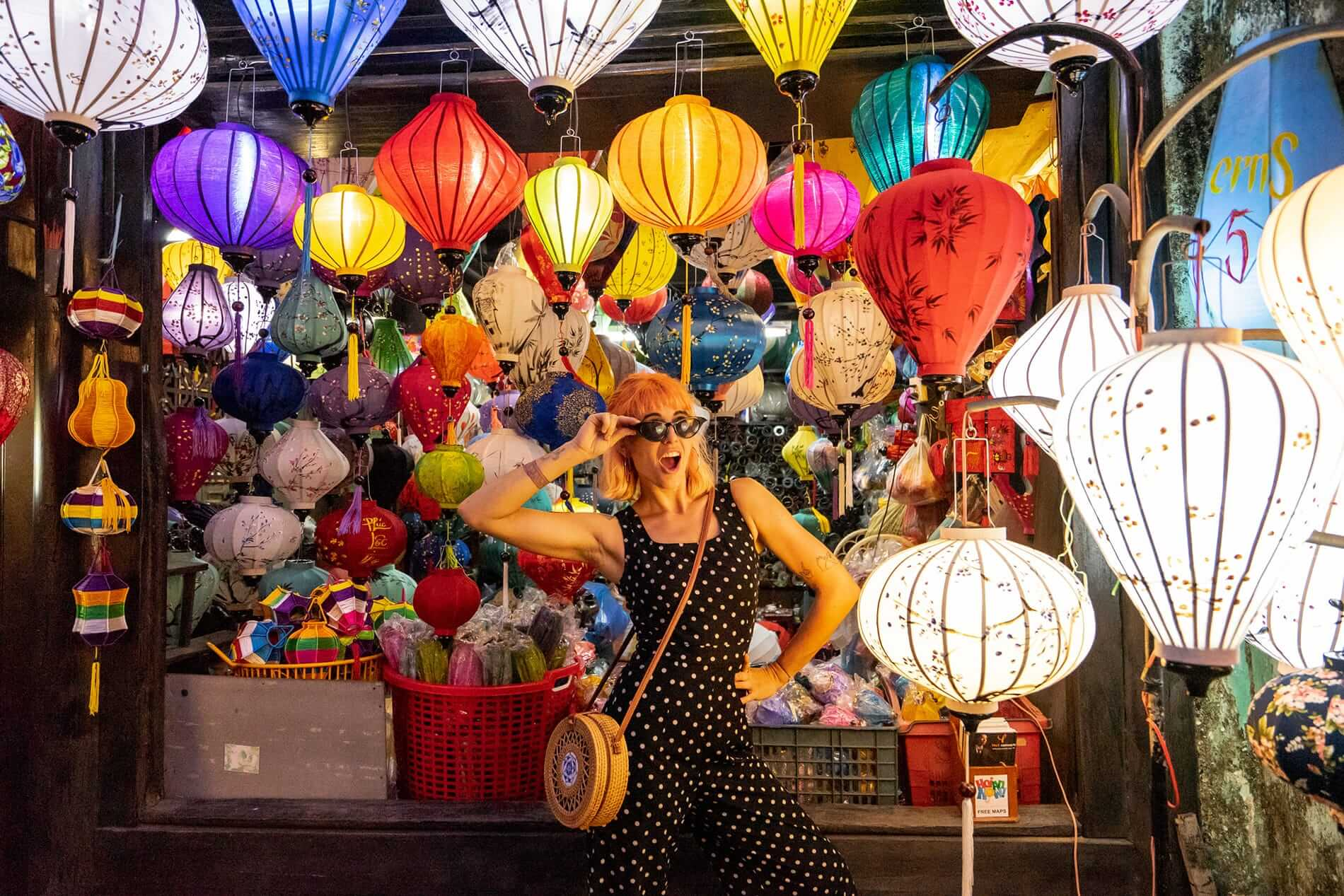 |
| Photo: Instagram |
Hoi An, once a major Southeast Asian trading post in the 16th and 17th centuries, is basically a living museum that houses old-town architecture.Some notable heritage buildings include Chinese temples, a Japanese-designed bridge, pagodas, wooden shop-houses, French-colonial houses, and old canals. Although large-scale trading had long moved elsewhere, Hoi An has been successful in preserving and restoring its charming roots and was declared a UNESCO World Heritage site in December 1999.
Hoi An Riverside is the best place to be at night as the area is lit by quaint and old-fashioned lanterns, making it an atmospheric and beautiful spot. For those who love sea, sun and sand, Hoi An offers two lovely beaches five kilometres away from the town centre – a sort of holiday within a holiday.
Hoi An is also known for its great food, fun shopping, skilled tailors, friendly people and cosy atmosphere – all key characteristics that draw people to this picturesque town.
Golden Hands Bridge
In the last few months, the Golden Bridge (Da Nang, Vietnam) has been creating a fever throughout the world with the appearance on not only many world-known channels and newspapers such as CNN, BBC, The Guardian, Times, etc. but also the most popular social networks and forums like Instagram, Facebook, Twitter, BuzzFeed, Reddit, etc.
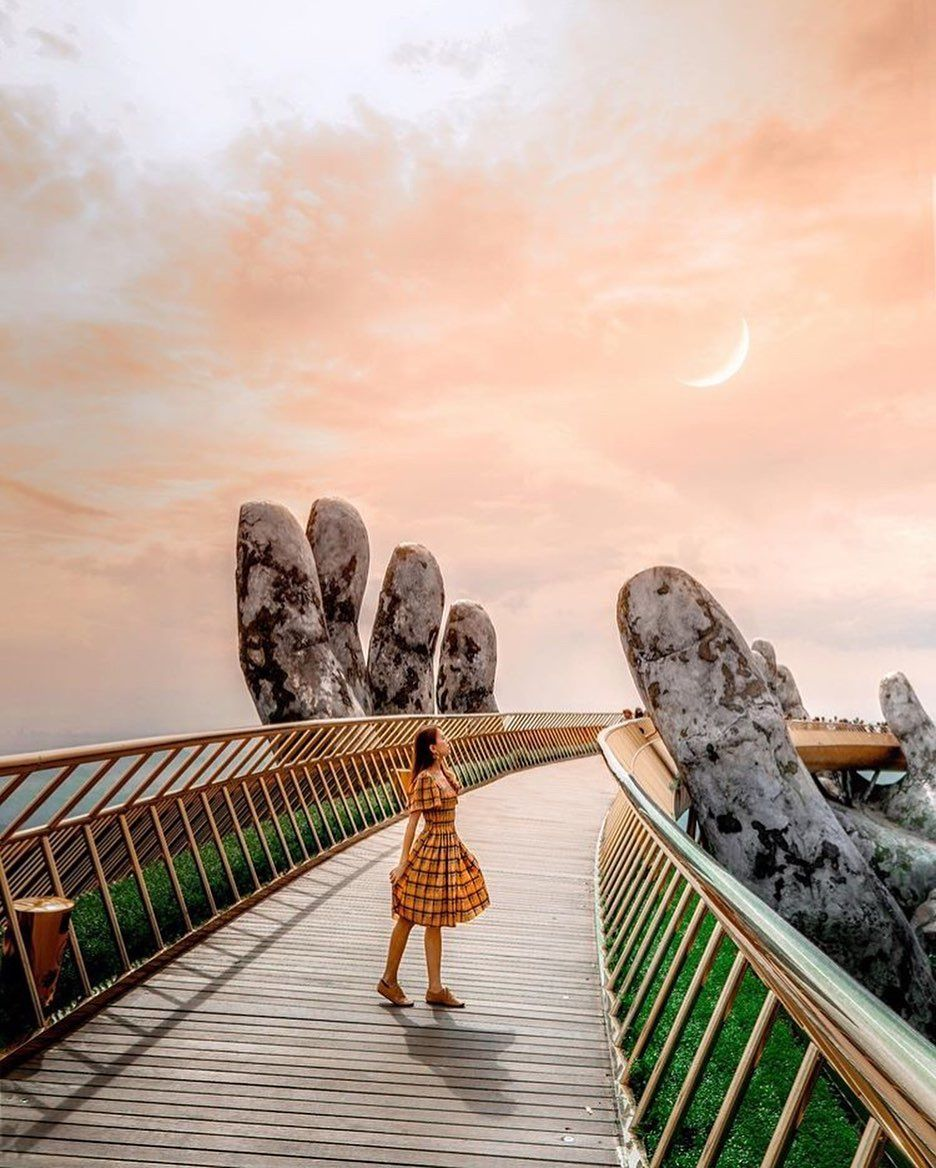 |
| Photo: @Backpackerstory |
Taking high ranking continuously on many architectural charts since the opening day and owning several magical and majestic short online videos also contribute to the fact that Golden Bridge is becoming a must-go place with the tourists who plan to visit Da Nang, Vietnam in the upcoming tourism season.
The Golden Bridge (Vietnam) is new architectural construction, which sets the location inside the Bana Hills entertainment – tourism complex. This bridge was built at the height of 1.400m above sea level and stretches about 150m long. The root of the name “Golden Bridge” comes from its gilded railing frame. More than being a pure architecture piece, Golden Bridge has been asserting itself as a new symbol of Da Nang’s tourism since the opening in June 2018.
Tourists flock here to take some pictures at the place where journalists and travel bloggers around the world are praising that being majestic and impressive as a scene in “Game of Thrones” or “The Lords of the Rings”. The image of a huge couple of ancient hands (which is like hands of the Mountain God) is lifting the bridge as a shining golden silk strip, toward the high blue sky with deep green forests below, actually is not inferior to any blockbuster’s scenes.



